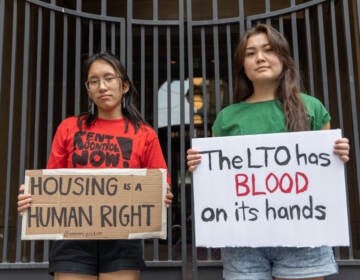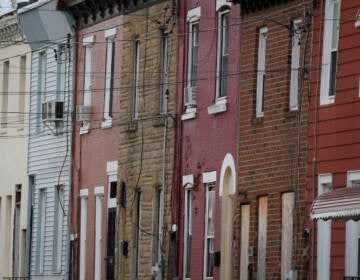With ‘tsunami’ of evictions looming and shelter space scarce, this could be a brutal winter for people without homes
In anticipation, housing support groups are scrambling to set up new systems, including ways for people to stay safe outside in freezing conditions.
Listen 4:32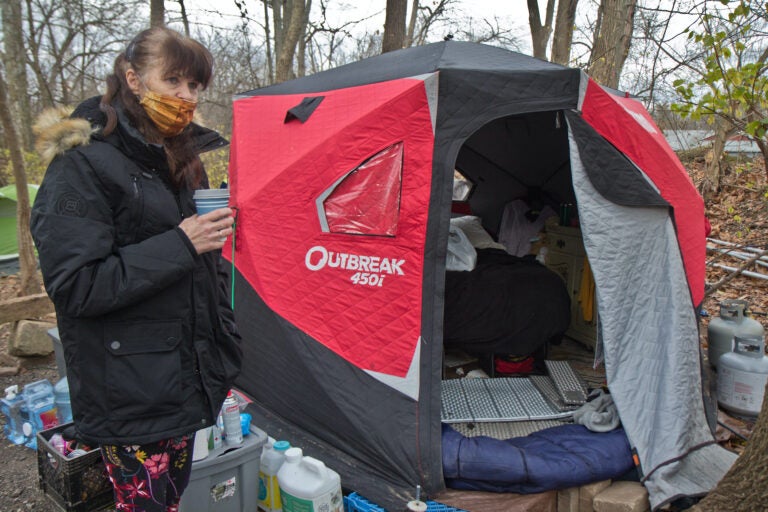
Dottie Spillane has been living near a creek in Norristown with her husband since the summer. She and her husband use a propane heater to heat their insulated tent as temperatures drop. (Kimberly Paynter/WHYY)
Ask us about COVID-19: What questions do you have about the current surge?
Digital signs around Norristown said it was 43 degrees, but with the wind it felt much colder in the small encampment by the banks of Stony Creek where Dottie and Mark Spillane have been staying.
The couple, both 60, have briefly been homeless before. Then, before the pandemic hit, Mark’s severe health issues cost him his job delivering used cars. With COVID looming, he couldn’t find a new one, and their landlord kicked them out.
“I was in the hospital, I was getting out, and I couldn’t get my rent paid. I couldn’t get back to work. It just was bad timing,” he said, of the pandemic shutting down workplaces.
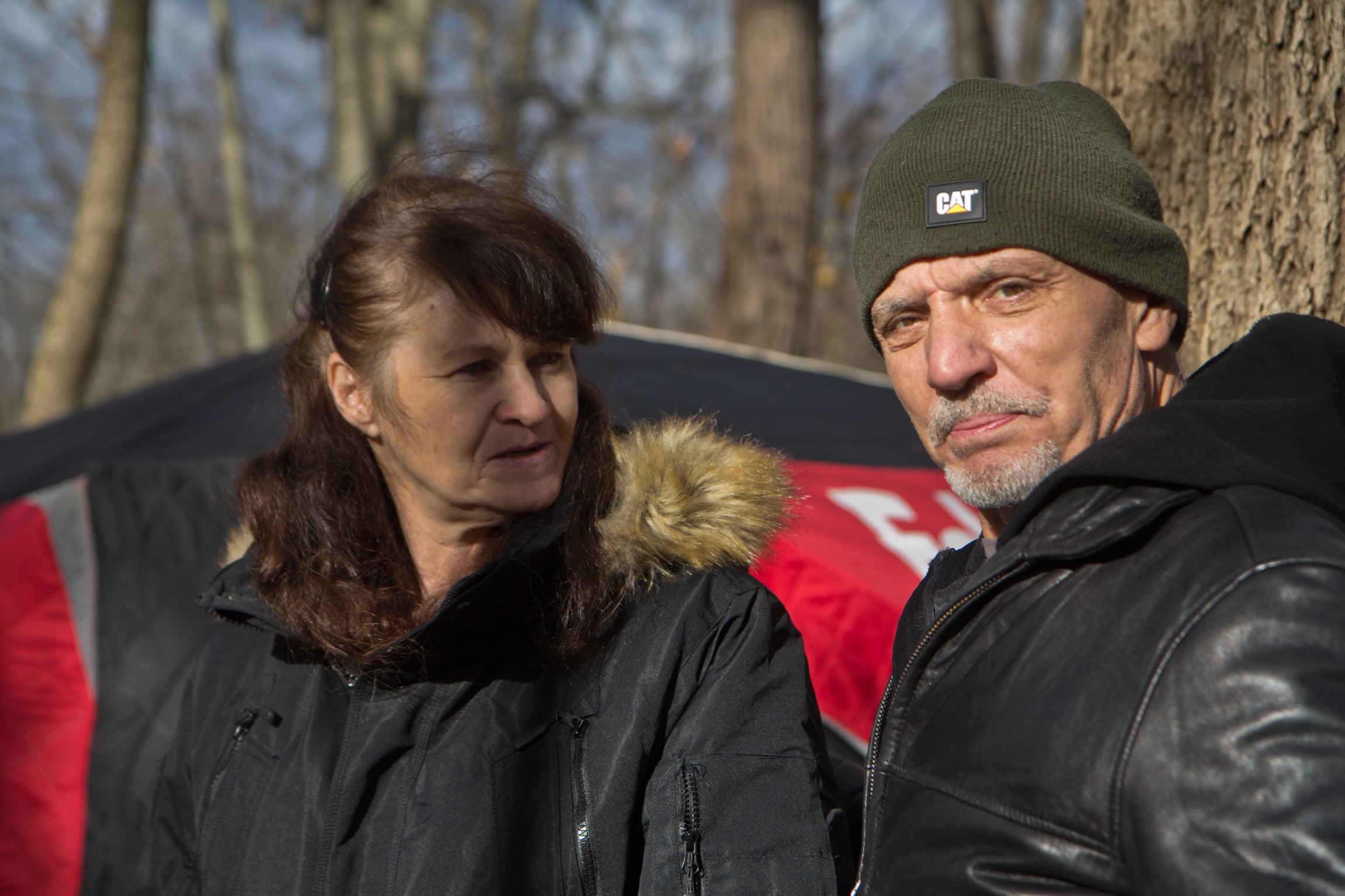
The couple is among the 15,000 Pennsylvanians experiencing homelessness on any given night, according to estimates by the Pennsylvania Department of Economic and Community Development.
As temperatures drop, housing groups across the commonwealth are faced with a double dilemma: pandemic safety rules have made shelter space scarcer, and the COVID-19 economy could lead to a wave of evictions in the dead of winter as a federal moratorium expires.
In anticipation, housing support groups are scrambling to set up new systems, including ways for people to stay safe outside in freezing conditions.
“This is a crisis response. For many of us, it feels like we can’t quite catch our breath,” said Mark Boorse, director of program development with Access Service, which does outreach to people experiencing homelessness in several eastern Pennsylvania counties.
The area where the Spillanes are staying has been the site of an informal encampment for a couple of years. This summer, Norristown officials started developing the ballfields adjacent to the creek, and it looked like the people staying there would have to leave. Then, the creek flooded and halted those plans. The storm also swept away much of Mark and Dottie’s possessions.
With redevelopment on pause, “for now, no one really cares about this space, and people came back to stay here,” said Boorse.
The Spillanes are trying to get an apartment. They have potential funding assistance through a county program, but it’s hard to find a landlord who will accept rent payment from a third party.
“We haven’t been able to get anything together,” said Mark.
‘Waiting for the shoe to drop’
Eight months of a pandemic and recession have made it even more difficult for those in need of affordable housing across the country.
In Pennsylvania, before COVID-19, a two-bedroom apartment was already unattainable for minimum-wage workers, according to a report by the National Low Income Housing Coalition.
Affordable rental properties in the mid-state region have become scarcer as people are staying put or looking to reduce their costs, according to Kelly Blechertas, program coordinator for the York County Coalition on Homelessness.
“The reality is the market is tighter than I’ve ever seen it, and trying to get an open unit is almost impossible,” she said. Landlords the coalition works with report getting more applicants than in non-pandemic times when units do become available.
Some people who lose their housing may never seek out homelessness support agencies — instead staying with friends or family members. But if people lose access to those informal networks, emergency shelter space has also grown scarce due to COVID-19.
“The chances of finding a place to go are really, really terrible right now,” said Anne Wright, a data scientist at Carnegie Mellon University who studies eviction.
In homeless shelters, statewide restrictions intended to keep the virus from leaping from person to person by spacing out individuals have reduced shelter capacity to 50% or 70% of what it was pre-coronavirus, said Blechertas.
Other spaces, such as day centers or even public libraries, which provide indoor respite, are closed. Charities, where one might normally sit down for a free meal, are still operating, but the food is to-go.
“During any given day, you’re outside for considerably longer periods of time because there’s such a restriction on where you can go inside,” said Boorse.
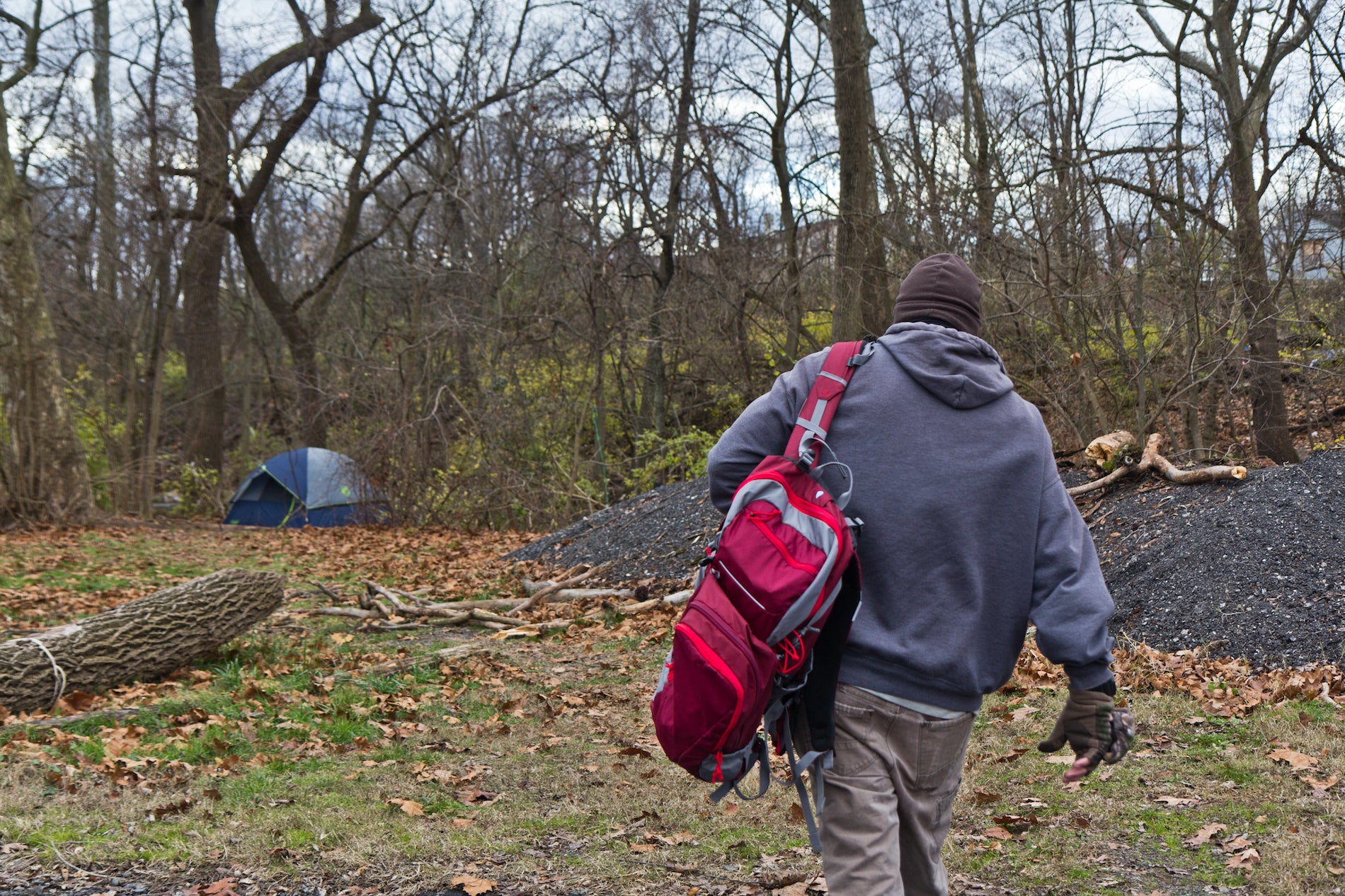
In order to shelter people safely, local governments have turned to novel alternatives.
Philadelphia took the step of leasing hotels, such as The Holiday Inn in Center City. First, the space was used for people exposed to the coronavirus to quarantine. Then, the city started allowing people experiencing homelessness to live there following blowback from housing support agencies.
In the mid-state area, renting blocks of hotel rooms is also an option some housing groups would like to pursue, but they face competition from another pandemic offshoot: fulfillment center workers.
Along I-83 in York County, warehouses for companies such as FedEx and Amazon have pulled in workers to meet holiday demand pumped up by the turn to online retail this year.
“We found hotel partners who were working with us, but they couldn’t work with us until January… [because] they were booked to capacity or close to capacity by distribution,” said Blechertas. “That was the first time I’ve heard that.”
Lisa Green, general manager of the Wyndham Garden in York, confirmed that the hotel has rented about 100 rooms to fulfillment center workers, more than during the holiday rush in years past. With the hotel business, like much of the service sector, suffering due to the coronavirus, “we’re thrilled to have them,” she said.
As a result, housing agencies in that area have had to turn to hotels further away from amenities and services “than we would be most comfortable with,” said Blechertas. Unlike shelters, where food and case support can be centrally located, hotels add logistical hurdles for all involved.
Motels are also where many people who lose their housing turn up on their own.
Reverend Matthew Best, of St. Stephen Lutheran Church in New Kingston, ministers to people experiencing homelessness along “Miracle Mile,” a stretch of US-11 in Cumberland County known for its truck stops, travel plazas and lodging.

Best said it’s not uncommon for families to spend $250-$450 a week on a motel while they wait to get a space in a shelter or into other supported housing — “far more than people pay in rent or a mortgage for a crappy hotel room that has a microwave,” he said. Others sleep in their cars.
They may not be formally considered “homeless,” but some of the people Best serves know that one more hardship could put them over the edge.
“I know a couple of people who are waiting for the shoe to drop,” said Best. “They’re working full-time. One is a single mother with three kids, but she knows this is coming. But she’s not in crisis yet.”
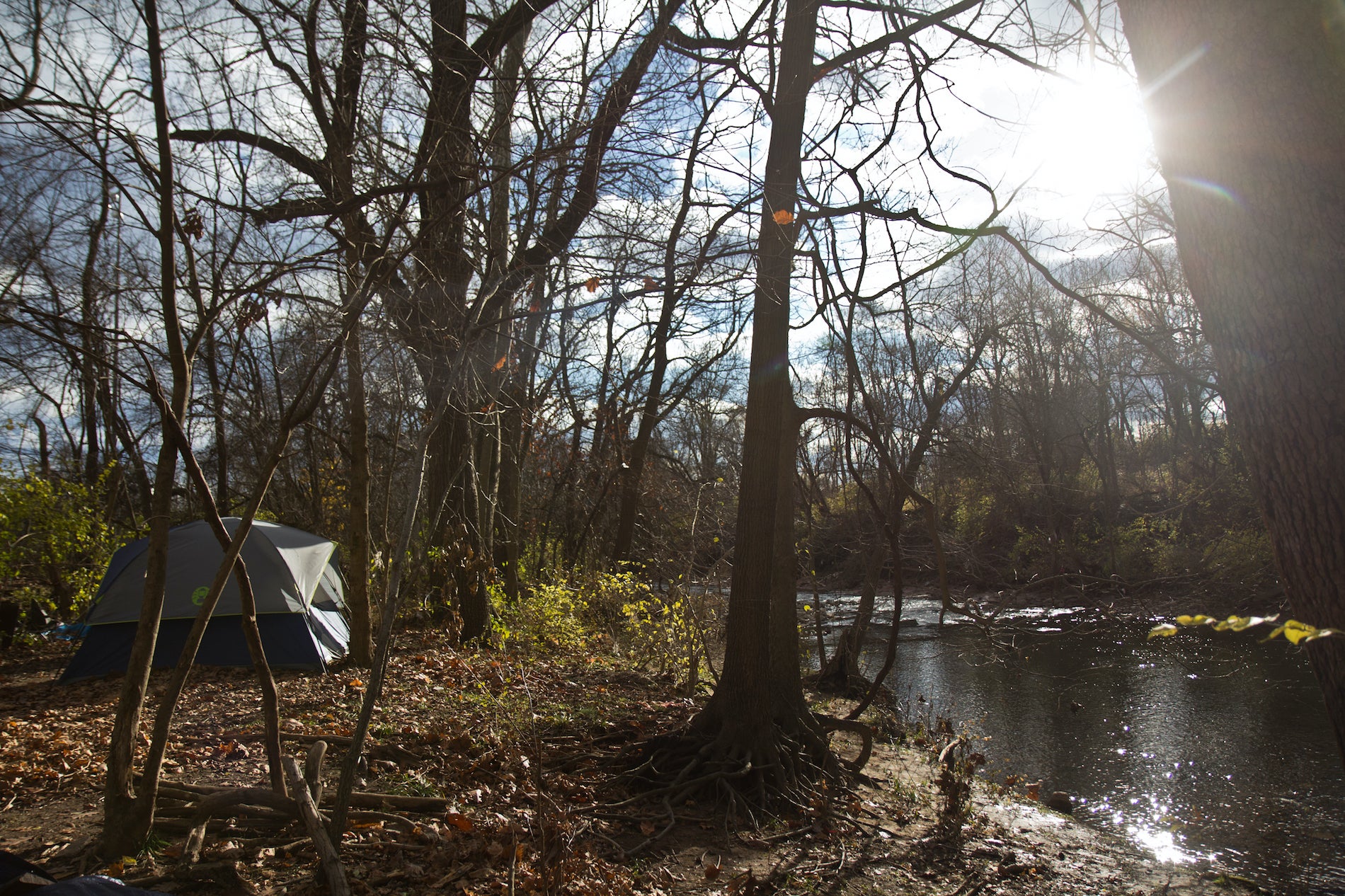
‘Nowhere to go’
One powerful tool to keep people sheltered expires at the end of this month: the eviction moratorium put in place in September by the Centers for Disease Control and Prevention.
Since March, a series of state and federal government orders to keep landlords from kicking out tenants who can’t pay have largely staved off a wave of evictions.
However, the CDC moratorium, which requires renters to know about it and mount a defense, has been unevenly interpreted with judges. Anne Wright, with Carnegie Mellon University in Pittsburgh, has been tracking evictions by scraping filings from online court dockets.
Her research shows earlier prohibitions on evictions caused filings to plummet, but under the CDC moratorium they have steadily crept up, in part because under that program the onus is on tenants to prove their case.
In the three days between when Pennsylvania’s earlier eviction moratorium expired, and when the CDC one took effect, 3,126 eviction notices were filed in 66 of Pennsylvania’s 67 counties according to Wright’s analysis. In Philadelphia, the only place not included in the CMU survey, 140 evictions were filed during the week of the gap, according to Princeton University’s Eviction Lab.
With that protection expiring at the end of December — and an extension currently debated in Congress still uncertain — many worry that the backlog of unpaid rent will lead to a wave of people being kicked out of their homes.
“Blessedly, because of the moratorium, fewer people than would have been dislodged have been dislodged, but the people who are being dislodged have freaking nowhere to go,” said an exasperated Wright.
Many tenants owe more than $5,000 in back rent, said Lori Leister of Bell Socialization Services in York and Adams Counties. That stat is supported by a recent study by Moody’s Analytics, which found that millions of Americans owe that amount or more in rent. In many cases, nonprofit housing assistance groups can provide some funds to help, but not enough to cover the need, so when the moratorium lifts they predict landlords will be ready to strike.
“Landlords have been waiting. They’ve got all their ducks in a row. They have all their paperwork in a row,” said Eduardo Esquivel, housing specialist with Nationalities Service Center. “The language that I’ve been hearing is a ‘wave of evictions, a tsunami of evictions.’”
Sanctuary space
With indoor space squeezed, some groups are looking at ways to keep people safe outdoors this winter.
One such space has cropped up at Union Lutheran Church in York, where people who had been evicted started showing up because they worried they would be mugged or hassled sleeping elsewhere.
“I have the people that are appearing on our steps, our property, sleeping at the church because they know it’s a safe place,” said Pastor Joel Folkemer. With more people outside as a direct result of shelter space restrictions, he said he’s looking to expand the church’s role in providing space as winter weather turns dangerous.
Code blue shelters, often overflow spaces crammed with people when the nighttime temperature drops to 20 degrees Fahrenheit, are also in short supply this year.
Folkemer plans to turn unused space in his church into a temporary, physically distanced shelter.
In late November, the York County Community Foundation announced that the county was short 195 shelter beds this winter, and announced plans to open a new space to try to meet that need. Last week, the Wolf Administration announced it would give out $3 million to beef up emergency cold weather shelters around the commonwealth.
In Montgomery County, Mark Boorse of Access Services is trying something different — making the outside warmer.
His organization has started putting together gear lists in an attempt to do that. Each one includes an insulated ice-fishing tent, a tent-safe heater, a generator, tarps and a five-gallon bucket to make a camp toilet.
“Relief work is taking care of people where they’re at,” he said while hoping eventually to get the amount of affordable housing and shelter space that an area needs.
“In Montgomery County, there’s no place where you’re actually allowed to be homeless,” Boorse said. This winter, his group is trying out the concept of “sanctuary space,” or small, sanctioned communities outside in otherwise unused areas.
“It’s sort of the idea of refuge,” he said.
Finding such space and making it safe isn’t cheap. The entire gear list runs around $800, and Boorse is trying to get people to sponsor individual sites and buy the gear.
The first recipients were Dottie and Mark Spillane. Mark leveled the ground in their camp and built a fireplace out of river stone. Inside their ice-fishing tent, there’s a dresser and a full-sized bed on risers. They also have an old laptop they charge on their generator.
When it’s cold, “we mostly watch movies,” said Dottie. They’re still looking for an apartment, but their small camp has already become a refuge to others.
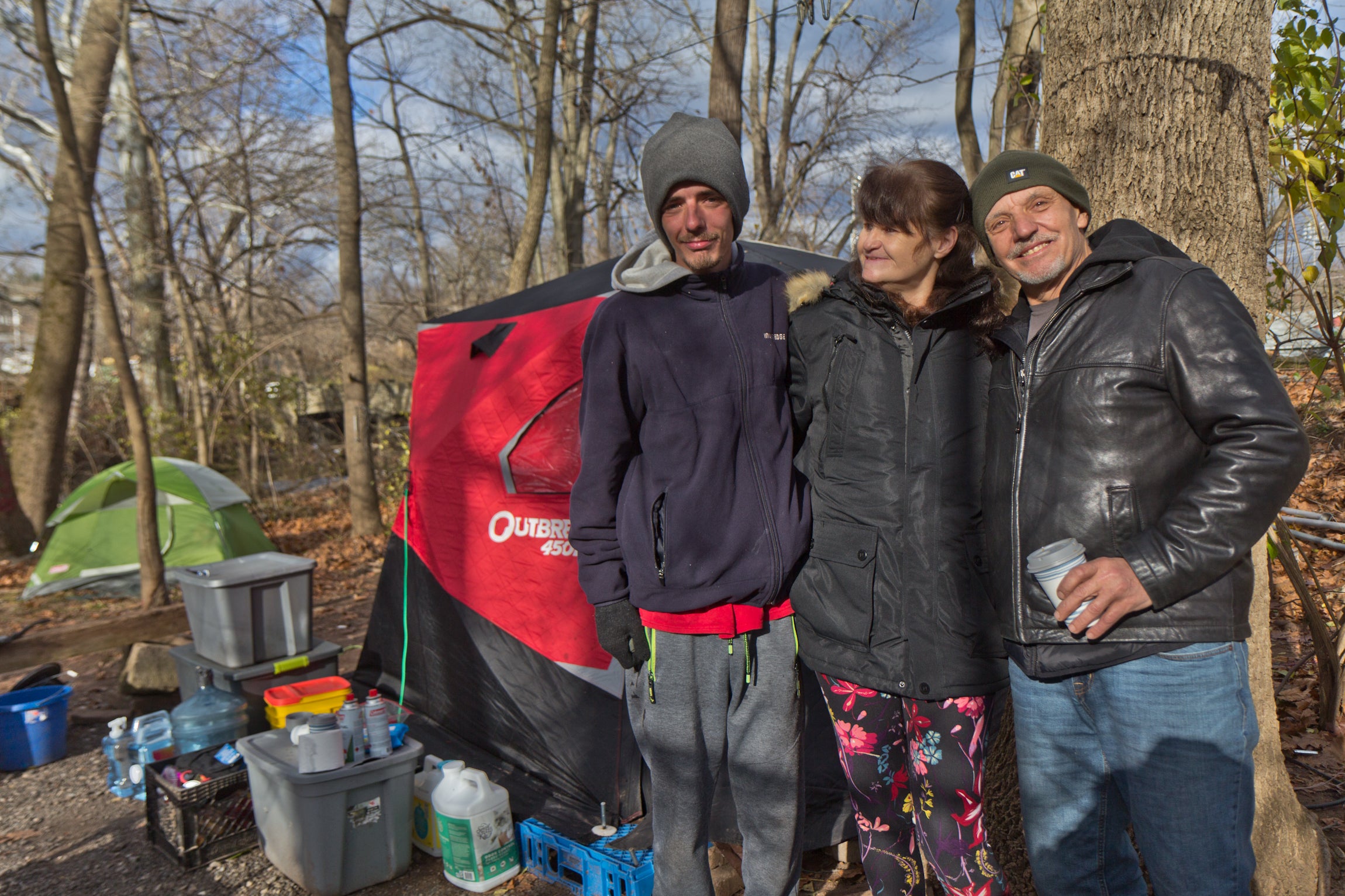
About a month ago, Sean McCormick, 32, joined their group. He stays nearby in a blue tent, but when temperatures drop, he joins Dottie and Mark in their larger, insulated one.
“If I didn’t find them, I would have froze to death,” he said.
 WHYY is one of over 20 news organizations producing Broke in Philly, a collaborative reporting project on solutions to poverty and the city’s push towards economic justice. Follow us at @BrokeInPhilly.
WHYY is one of over 20 news organizations producing Broke in Philly, a collaborative reporting project on solutions to poverty and the city’s push towards economic justice. Follow us at @BrokeInPhilly.
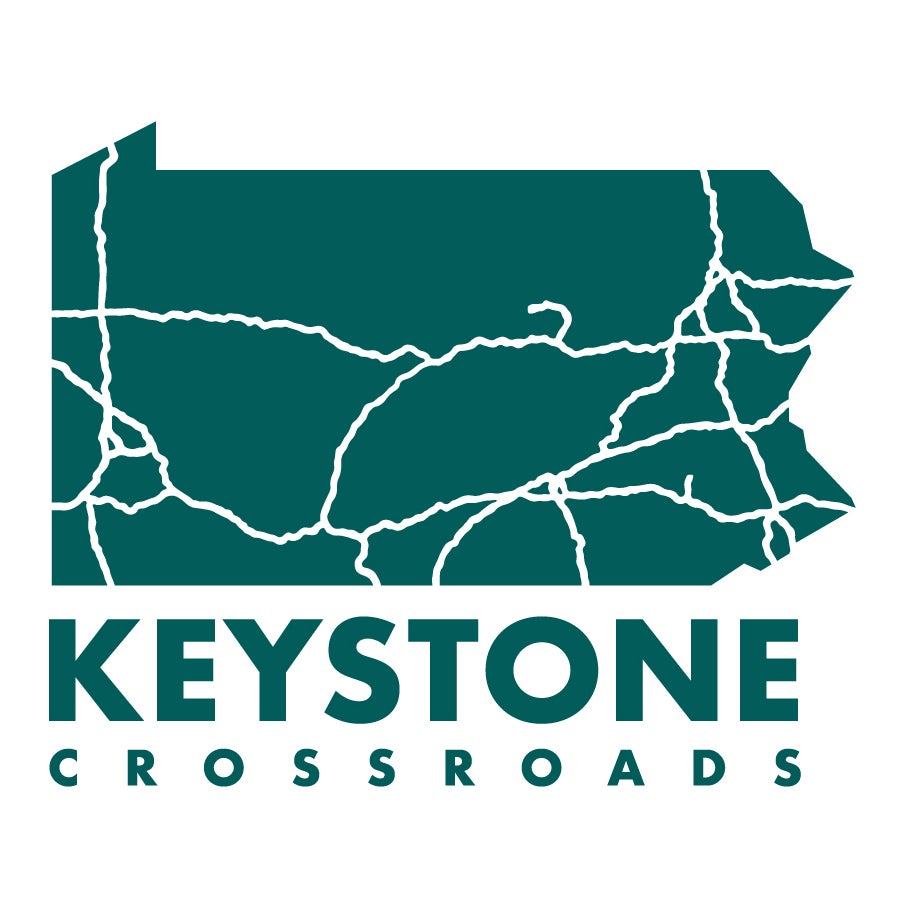
Get more Pennsylvania stories that matter
WHYY is your source for fact-based, in-depth journalism and information. As a nonprofit organization, we rely on financial support from readers like you. Please give today.



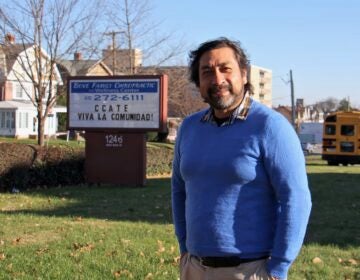
![CoronavirusPandemic_1024x512[1]](https://whyy.org/wp-content/uploads/2020/03/CoronavirusPandemic_1024x5121-300x150.jpg)
